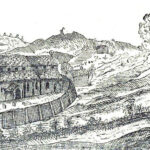8 June 1561: A York official explains why textile manufacturing has left his city for the West Riding
Herbert Heaton. 1920. The Yorkshire Woollen and Worsted Industries, from the Earliest Times Up to the Industrial Revolution. Oxford: Clarendon Press. Get it:
.Excerpt
The cause of the decay of the weavers and looms for woollen cloth within the said city as I do understand and learn is the lack of cloth-making in the said city as was in old time accustomed, which is now increased and used in the towns of Halifax, Leeds, and Wakefield, for that not only the commodity of the watermills is there nigh at hand, but also the poor folk as spinners, carders, and other necessary work-folks for the said weaving, may there beside their hand labour, have rye, fire, and other relief good cheap, which is in this city very dear and wanting.
Comment
Comment
York Corporation minute books, 8 June 1561.
The watermills are fulling mills, which were present on the Aire and the Calder and at Burnley, Colne and Manchester before Edward III. Cloth manufacture in the West Riding did not originate with the Flemish weavers invited by him, but York and other corporate towns (Beverley, Hull, Ripon and Pontefract) long dominated both manufacture and trade. A sign of this is the far greater antiquity of the York craft guilds and their mystery plays vis-à-vis Wakefield’s guilds and Towneley plays, which were derivative and may actually have been performed elsewhere (Crump 1935).
I take it that “fire” refers to coal. Chapter II of Crump and Ghorbal’s history of the Huddersfield woollen industry deals with the physical setting principally from an 18th century perspective, but in the mid-16th century wood was increasingly scarce and domestic hearths were well able to cope with coal, and the following works pretty well transposed back a couple of centuries before the Industrial Revolution:
The well-watered but otherwise barren and inhospitable country of the Grits proved itself fitted to nurture the weaving of wool; only it needed to be in contact with the Coal Measures to create a woollen industry. No conclusion emerges from the history of the industry more clearly than that its distribution has been dependent upon the contiguity of the Lower Coal Measures and the Millstone Grits. Both had abundance of soft water and of forest; but the Coal Measures possessed greater wealth of ironstone and coal, there elevation was less, their soil deeper and habitable sites less bleak. So natural advantages weighted the scales in favour of the villages set on or near the fringe of the Lower Coal Measures. They became possessed of churches and their parishes ran far up into the hills, annexing all the Grit country with its smaller villages and townships. They became market towns and grew to be “clothing” towns – the centres of the cloth trade of their own wide parishes. With slight individual variations Huddersfield, Halifax, Bradford and Leeds on the one side, Rochdale, Bury, Burnley and Colne on the other have all risen in this way (Crump 1935).
Something to say? Get in touch
Original
The cause of the decay of the … weavers and looms for woollen [cloth] within the said city as I do understand and learn is the lack of clothmaking in the said city as was in old time accustomed, which is now increased and used in the towns of Halifax, Leeds, and Wakefield, for that not only the commodity of the watermills is there nigh at hand, but also the poor folk as spinners, carders, and other necessary work-folks for the said weaving, may there beside their hand labour, have rye, fire, and other relief good cheap, which is in this city very dear and wanting. [York Corporation Minute Books, xxiii, f. 20 a, June 8, 1561]
115 words.
Similar
Search
Donate
Music & books
Place-People-Play: Childcare (and the Kazookestra) on the Headingley/Weetwood borders next to Meanwood Park.
Music from and about Yorkshire by Leeds's Singing Organ-Grinder.




 Bluesky
Bluesky Extwitter
Extwitter